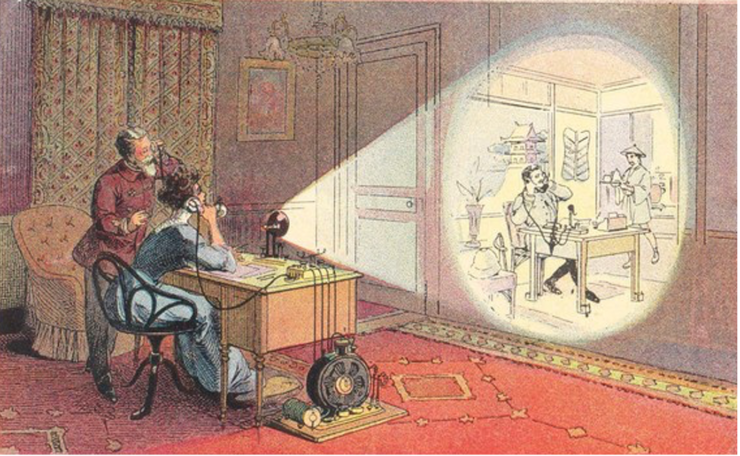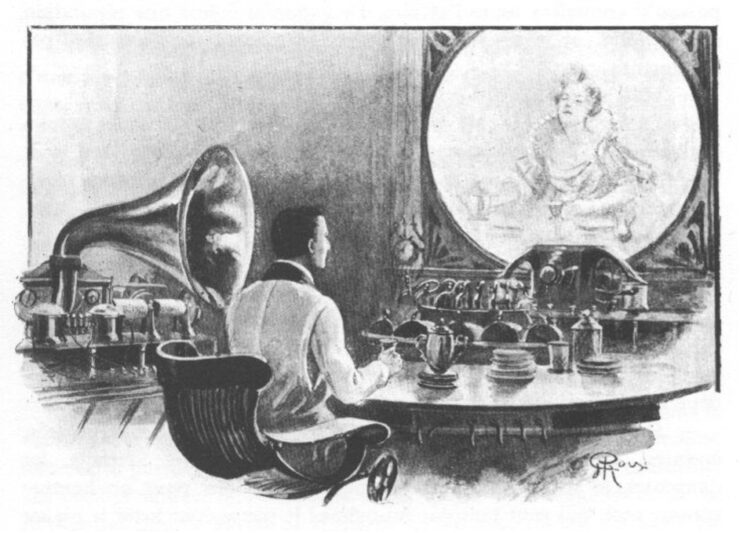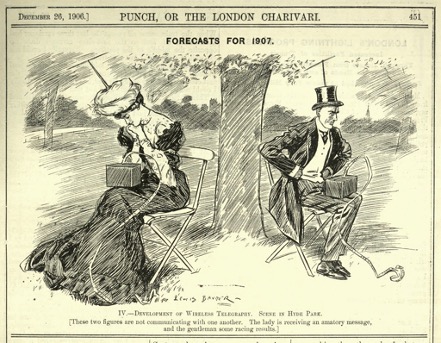Documentation
[Recap] TiM Seminar 2022-23 “Media Imaginaries / Imaginary Media / Imaginations of Media” – Frank Kessler and Imar de Vries (UU)
“Imaginary Media and the
Pursuit of the Impossible Dreams”
by Olga Efremova

The first in 2022-23 Transmission in Motion seminar series opened with a welcome from Dr. Maaike Bleeker, who introduced media history researchers from Utrecht University Dr. Frank Kessler and Dr. Imar de Vries. The first part of the seminar consisted of the speakers’ presentation, followed by the discussion session in the second part where the presenters took questions and comments from the audience. In the introduction to the seminar topic Frank Kessler brought to the attention of the participants the need to differentiate between three types of the imaginaries. Kessler used the example of the “magic mirror”, a magical communication device used by the Wicked Witch in Wizard of Oz film to spy on Dorothy and her friends, to highlight the impossible nature of imaginary media. Imar de Vries further emphasised that imaginary media should be understood as the media that cannot really exist; they are not just fiction, but rather impossible dreams. Kessler elaborated on the various historical drives for imaginary media, pointing out that many of such devices were inspired by the desire to communicate with the dead: this connection between the concepts of “media” and “medium” was later revisited during the Q&A session.
Kessler brought the attention to a variety of late XIX-early XX century visions for possible future media, such as one depicted in the illustration to Jules Verne’s La journée d’un journaliste américaine in 2889 (1889). As can be seen in Figure 1, one of the remarkable features of such depictions was the pervasive combination of futuristic technology with the existing household devises, interior elements of décor and clothing fashions of the time. Kessler pointed out that these made-up devises were framed differently at different points in time: as part of the genealogy of television, interactive television, future of telephone, videophone or even as a prediction of today’s Zoom application. Similarly, 1881 depiction of the future theatre that features a device called “theatrophone” were open to a variety of interpretation that, according to Kessler, are in most part extrapolations of very recent inventions.
Imar de Vries further emphasised that these discussions were never meant to establish the origin of the contemporary media or to validate the predictions of their inventions, but rather used as legitimisations of their use. Kessler and de Vries also commented on the fact that such prediction often appeared in ironic context, such as cartoons in Punch magazine (Figure 2). Speaking about “ironic imaginaries”, de Vries drew a parallel between Punch caricatures and contemporary popular culture visions of future media such as Black Mirror. In his view both are the representation of the possible scenarios taken to the extreme. In Kessler’s view there are two sides to future media imagination: one is the extrapolation of the existing technology, the other one is a discussion of the socio-cultural effects of the media brought about by possible tech advances that may or may not become part of the contemporary reality but are often fed through the current situation.

Figure 1. An illustration to Jules Verne’s La journée d’un journaliste américaine in 2889 (1889).

Figure 2. An illustration from Punch magazine (1906).
When introducing the concept of “technological imaginaries”, de Vries reflected on how hope and desires of the current times, such as the desire to bring close(r) exotic or erotic, become the drivers for the speculations on the potential future uses of media technology. These representations, according to Lister (2009) are imbued with a deep sense of déjà vu: “[T]he repetition of deeply ingrained ways in which we think, talk, and write about new […] technologies” (69). Noting that technology allows for a lot of daydreaming, de Vries emphasised that such imaginaries should be seen as myths that retrospectively act as legitimization for the ideological forces that drive the myth creation. As exemplified by 1950s educational film where children were being taught about the telephone, the legitimization of the telephone invention that embodies all western ideas about utopia could be seen as a manifestation of the perceived lack and the desire to become whole.
That kind of legitimisation can lead, in de Vries’ opinion, to a dangerous assumption about the linear path of progress. The imaginaries as ideological driving forces reinforce the view that there is an inherent communication need that makes the invention of a particular technology inevitable. Similar to the myth of the Tower of Babel, the myth of a media imaginary based on the idea the imaginary lack of common tongue is what divides us, propagates the conceptual vision of “a great human family”. That sentiment, de Vries argued, echoes Paul Otlet’s vision of The Universal Communication Language. The technology that could enable the knowledge repositories containing “millions of index cards” would eventually mean that humans could become “God himself”.
The presentation session concluded with the reflection on the contemporary state of technological imaginaries and the stories and myth that fuel today’s interest in the future of media technology. The seminar participants were invited to further elaborate in this question during Q&A session, where such questions as the limits of the imaginaries were raised. Responding to the question, Kessler and de Vries argued that while many ideas from the future media come from popular culture and may or may not take the same form in the context of technological campuses, most examples quickly come back to existing ideas. Another popular focal point of today’s technological imaginaries, according to Kessler, is “a myth of total cinema” based on the argument that to experience the complete immersion we need to get rid of the film strip and screen. Bringing as the example the development of 3D technology post Avatar, Kessler pointed out that the imaginaries often lead to the expectations that are beyond realistic. While 3D technology, driven but the desire for “falling into the story world”, worked well for some of visual content, such as action film with strong affective component and some documentaries, it has not fully displaced traditional cinema. The discussion wrapped up with the observation that most technological imaginaries presented are the representation of western class-based utopias of “rich people’s futures” and that looking at the visions coming from other social and ideological contexts could further expand our understanding of imaginary media.
References
Fairbanks (Jerry) Productions. 1965. We Learn About the Telephone I. Online Video. Internet Archive. Accessed on November 14, 2022. https://archive.org/details/WeLearnA1965
Lister, Martin, Dovey, Jon, Giddings, Seth, Grant, Iain, and Kelly, Kieran. 2008. New Media: A Critical Introduction (2nd ed.). London: Routledge.
Utrecht University. 2022. “Media Imaginaries / Imaginary Media / Imaginations of Media” – Frank Kessler and Imar de Vries (UU). Transmission in Motion. Accessed November 9, 2022. https://transmissioninmotion.sites.uu.nl/media-imaginaries-imaginary-media-imaginations-of-media-frank-kessler-and-imar-de-vries-uu.

